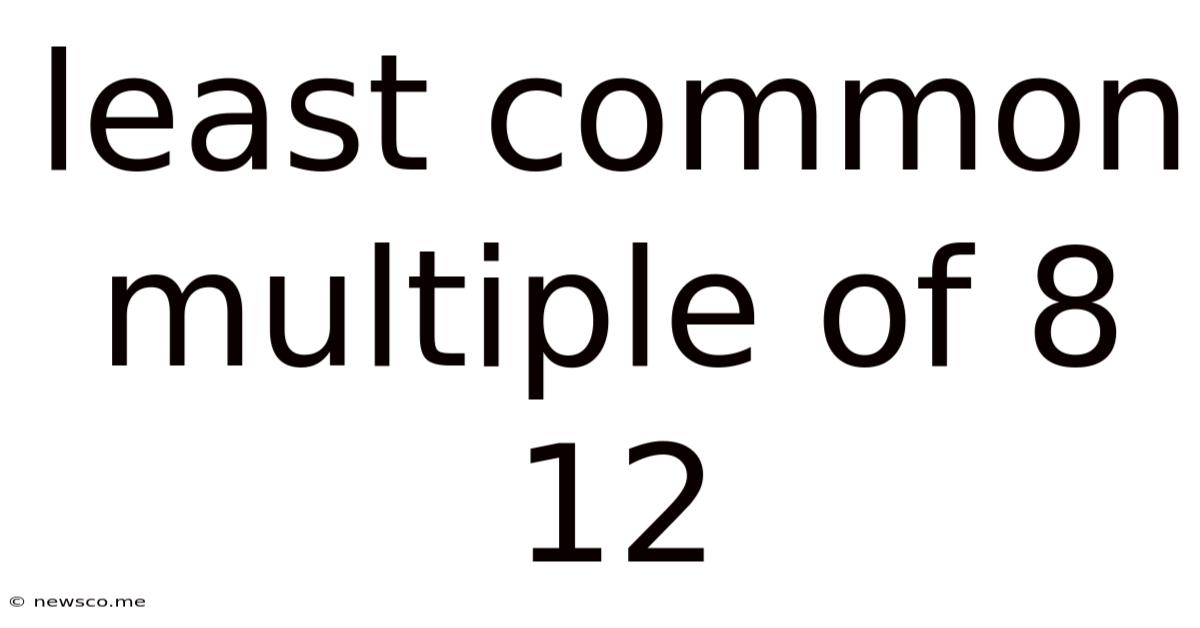Least Common Multiple Of 8 12
News Co
Apr 21, 2025 · 4 min read

Table of Contents
Finding the Least Common Multiple (LCM) of 8 and 12: A Comprehensive Guide
The least common multiple (LCM) is a fundamental concept in mathematics, particularly in number theory and algebra. Understanding LCM is crucial for solving various problems, from simplifying fractions to scheduling events. This article delves deep into the concept of LCM, focusing specifically on finding the LCM of 8 and 12, while also exploring different methods and their applications. We'll cover various techniques, from prime factorization to the use of the greatest common divisor (GCD), ensuring a comprehensive understanding for all levels of mathematical proficiency.
What is the Least Common Multiple (LCM)?
The least common multiple (LCM) of two or more integers is the smallest positive integer that is divisible by all the integers. In simpler terms, it's the smallest number that all the given numbers can divide into evenly without leaving a remainder. For example, the LCM of 2 and 3 is 6 because 6 is the smallest number divisible by both 2 and 3. This concept extends to more than two integers as well.
Methods for Finding the LCM of 8 and 12
Several methods can effectively determine the LCM of two numbers. Let's explore the most common approaches, applying them to find the LCM of 8 and 12:
Method 1: Listing Multiples
This is the most straightforward method, particularly useful for smaller numbers. We list the multiples of each number until we find the smallest common multiple.
- Multiples of 8: 8, 16, 24, 32, 40, 48, 56, 64...
- Multiples of 12: 12, 24, 36, 48, 60, 72...
By comparing the lists, we see that the smallest common multiple is 24. Therefore, the LCM(8, 12) = 24. While simple, this method becomes less efficient with larger numbers.
Method 2: Prime Factorization
This method is more efficient for larger numbers. It involves finding the prime factorization of each number and then constructing the LCM using the highest powers of all prime factors present.
- Prime factorization of 8: 2³ (8 = 2 x 2 x 2)
- Prime factorization of 12: 2² x 3 (12 = 2 x 2 x 3)
To find the LCM, we take the highest power of each prime factor present in the factorizations:
- Highest power of 2: 2³ = 8
- Highest power of 3: 3¹ = 3
Therefore, LCM(8, 12) = 2³ x 3¹ = 8 x 3 = 24
Method 3: Using the Greatest Common Divisor (GCD)
The LCM and GCD (greatest common divisor) of two numbers are closely related. The product of the LCM and GCD of two numbers is always equal to the product of the two numbers. This relationship provides an alternative method for calculating the LCM.
First, we find the GCD of 8 and 12 using the Euclidean algorithm or prime factorization.
- Prime factorization of 8: 2³
- Prime factorization of 12: 2² x 3
The common prime factor is 2², so GCD(8, 12) = 2² = 4.
Now, we use the formula:
LCM(a, b) = (a x b) / GCD(a, b)
LCM(8, 12) = (8 x 12) / 4 = 96 / 4 = 24
Applications of LCM
The concept of LCM has numerous applications across various fields:
1. Fraction Simplification
Finding the LCM is crucial when adding or subtracting fractions with different denominators. We find the LCM of the denominators to create a common denominator, simplifying the addition or subtraction process.
2. Scheduling Problems
LCM is invaluable in solving scheduling problems. For instance, imagine two buses departing from a station at different intervals. The LCM of their departure intervals helps determine when they will depart simultaneously again.
3. Cyclic Patterns
Many real-world phenomena exhibit cyclic patterns, such as the rotation of planets or the phases of the moon. The LCM helps determine when these cycles align or repeat.
4. Music Theory
In music theory, the LCM helps determine the least common denominator for different rhythmic patterns, assisting in harmonizing musical compositions.
5. Computer Science
In computer science, particularly in areas like concurrency and scheduling, the LCM plays a role in optimizing resource allocation and task synchronization.
Beyond 8 and 12: Extending the Concepts
The methods described above can be extended to find the LCM of more than two numbers. For prime factorization, we simply consider all prime factors present in the factorizations of all the numbers, taking the highest power of each. For the GCD-based method, we can iteratively apply the process, finding the LCM of two numbers at a time.
For example, to find the LCM of 8, 12, and 15:
- Prime factorization of 8: 2³
- Prime factorization of 12: 2² x 3
- Prime factorization of 15: 3 x 5
The LCM would be 2³ x 3 x 5 = 120
Conclusion: Mastering the LCM
The least common multiple is a fundamental mathematical concept with far-reaching applications. Understanding the various methods for calculating the LCM, from listing multiples to prime factorization and using the GCD, empowers you to tackle a wide range of problems effectively. Whether simplifying fractions, solving scheduling puzzles, or understanding cyclic phenomena, the LCM provides a powerful tool for solving mathematical problems and understanding real-world patterns. By mastering these concepts, you equip yourself with a valuable skill applicable across multiple disciplines. Remember that practice is key to solidifying your understanding and developing proficiency in calculating LCMs for various sets of numbers.
Latest Posts
Related Post
Thank you for visiting our website which covers about Least Common Multiple Of 8 12 . We hope the information provided has been useful to you. Feel free to contact us if you have any questions or need further assistance. See you next time and don't miss to bookmark.